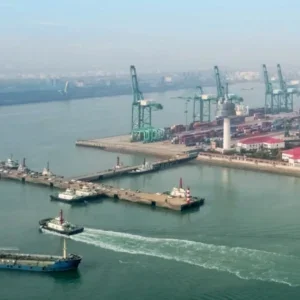The addition of the port equipment businesses to the Terex Cranes stable means the addition of a number of new product lines to its global offering, including rubber-tyred and rail-mounted gantry cranes, mobile harbour cranes and ship-to-shore cranes. Terex’s established foothold in this market has been through its reachstacker line.
“Fantuzzi and Noell are unquestionably leaders in the design, manufacture and service of port equipment,” Rick Nichols, president of Terex Cranes, said in the announcement of the deal. “This acquisition also helps diversify our cranes business, and expands the product offering of Terex Cranes to the port industry beyond our current stacker line.”
“As one of the world’s leading manufacturers of cranes, we are committed to growing our global presence to serve the variety of industries that require specialised lifting capabilities,” says Thomas Ostermann, vice president and managing director of Terex Cranes. “We were already in the port equipment business in a limited way with our French-made reachstacker range, which we acquired with our purchase of PPM in 1995. We see the acquisition of the Fantuzzi and Noell businesses with their range of harbour and stacking cranes, straddle carriers and container/reachstackers as providing an important growth opportunity in the intermodal transportation area of infrastructure. These products complement our existing reachstacker range and provide an excellent value creation opportunity for our customers and investors.”
The completion of the deal brings to an end the year-long takeover, which started in August 2008. On 11 August, 2008, Terex announced it had reached an agreement with Fantuzzi to buy its port equipment businesses for EUR215m. Terex Corp’s chairman and CEO Ron DeFeo described the acquistion as “an excellent fit with our strategy of expanding our market presence and a natural extension of our crane business.”
On 19 November, the European Commission ruled in its favour, saying there was little cause for concern over competition issues and that both firms “would continue to face several strong, effective competitors”. However, just two days later, Terex informed the US Securities and Exchange Commission (SEC) that it was concerned a “material adverse change” had occurred with respect to the Fantuzzi business and that this “may preclude completion of the acquisition”. Terex moved to request additional information from Fantuzzi and entered into various negotiations on the future of the deal.
However, these discussions proved fruitless and on 18 December, Terex announced to the SEC that it had informed Fantuzzi that it was terminating the deal with immediate effect. Fantuzzi reacted negatively to the reasons cited by Terex for the termination of the deal, and started arbitration proceedings in Italy on 24 December.
The following months continued to see the two firms locked in discussion over the takeover, until on 1 April, 2009 Terex announced to the market that it had agreed a new deal valued at EUR175m to buy the Fantuzzi businesses. This was followed by the announcement on 27 July that the deal had been completed for approximately EUR155m.
“The operations are now solidly part of our Terex Cranes business segment,” says Ostermann. “We expect to supply the Terex business system approach to introduce lean manufacturing and related techniques to help improve Fantuzzi operations.
“If you are talking about the Fantuzzi and Noell brands and how the equipment will be marketed and branded, it’s too early to say. Our clear goal is to build a strong franchise for the Terex brand in our cranes business segment, and across our portfolio.
“We are respectful of customer perceptions and their familiarity with the brands that become part of our company,” he says. “Our intent is to take the appropriate steps to achieve a smooth transition.”
Ostermann says Terex is looking to develop the new harbour crane arm of its cranes business, although this will be affected by the global economy.
“We view port equipment as an important market for us as an infrastructure company and have plans to grow this business over time and make it a profitable contributor to Terex,” says Ostermann. “How fast and in what way we accomplish that will depend, of course, on the recovery in world trade and resulting port equipment demand.
“We are truly excited to have the Fantuzzi and Noell businesses as part of Terex and will work to ensure that our customers in both the port equipment and lifting segments will benefit from our expanded product and service offerings.”






